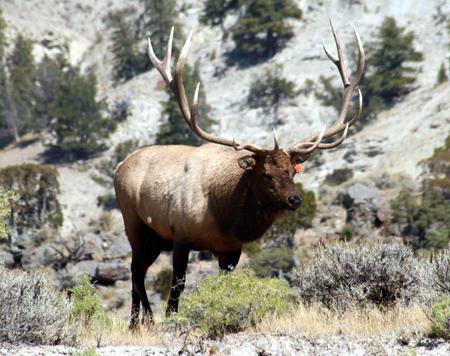It's difficult to imagine an elk being clumsy, especially one that has lived 15 years, carried an impressive rack, and sired who knows how many offspring. But that apparently is behind the death of a bull elk at Yellowstone National Park.
Sadly, park officials say old "Number 6" was found dead in Gardiner, Montana, earlier this week, the victim of, ahem, apparently tripping while trying to cross a fence line.
Number 6, who got the name from his orange and black ear tag, was found dead Sunday night. Montana Fish, Wildlife, and Parks staff members believe the animal tripped while trying to cross a fence and somersaulted onto his back, where he was pinned between rocks with his antlers beneath him and suffocated.
Yellowstone officials say an ensuing necropsy indicated that the bull was at least 15 years old and weighed 725 pounds. For comparison sake, elk have an average life span of 13 to 18 years, with bulls typically topping the scales at 700 pounds, they said.
Number 6's rack, though diminished in size from previous years, still gross-scored an impressive 356-5/8 on the Boone and Crockett scale. At his peak, the animal would certainly have been considered a “trophy” by elk hunters.
Yellowstone officials note that several large bulls with impressive antlers venture into Mammoth Hot Springs each fall to compete for the attention of cow elk during mating season. The aggressive behavior of these animals brings with it a threat to people and property.
Number 6, and his regular sparring partner Number 10, were both ear-tagged several years ago. Number 6 had his antlers removed in August 2004 and again in August 2005 in an effort to reduce the danger he posed to park visitors. Number 10 was last seen in the Mammoth Hot Springs area shortly after the rut concluded.
For safety's sake, park regulations require people to stay at least 25 yards away from most animals and at least 100 yards away from bears and wolves at all times. Visitors desiring a closer look at animals should use binoculars, spotting scope, or the zoom lens on their still or video camera.




Comments
I know I had seen that elk. What a sad end.
Jim Macdonald
The Magic of Yellowstone
Yellowstone Newspaper
Jim's Eclectic World
I have enjoyed watching #6 also. He was a beautiful specimen. He will surely be missed especially next fall but he has left a number of offspring of us to enjoy.
I am sure that he had crossed that fence dozens of times in the past. Perhaps he just wasn't as nimble as he used to be? Something I can relate to. In any case, I always thought this onery old guy would go down fighting. I ran into him in the back country a few years ago near Mammoth. He appeared at the top of a hill about a hundred yards away. He saw me at the same time I saw him, and started pawing the ground and bugling. I saw the red tag and knew of his reputation. Before I knew it he charged down the hill and I had to take refuge in some deadfall. He poked at me with those massive antlers again and again until, realizing that he couldn't get to me, he backed off and bugled several times before tearing up some sage brush and a couple of saplings. Finally he returned to his harem and I made my escape. A magnificent, totally fearless animal; he was as docile as a cow when I would see him grazing peacefully during winter with arch enemy #10 in the "valley of the bulls" (an area around Wraith Falls where bull elk often winter)...the last time perhaps a month ago. A park icon, much like wolf 21m, grizzly 264 and black bear "Rosie", he will be missed.
Heres some pics I took of him in my yard in Gardiner
http://brockkuntz.shutterfly.com/
and some videos
http://www.youtube.com/watch?v=C6lg8PBaHwo
http://www.youtube.com/watch?v=D33WV0b3yJo
http://www.youtube.com/watch?v=PqkOKDGPV_A
This elk was one in a million and he will be missed. He wasnt aggresive in the winter. After the rut he was soo chill. Just hanging out in Gardiner.